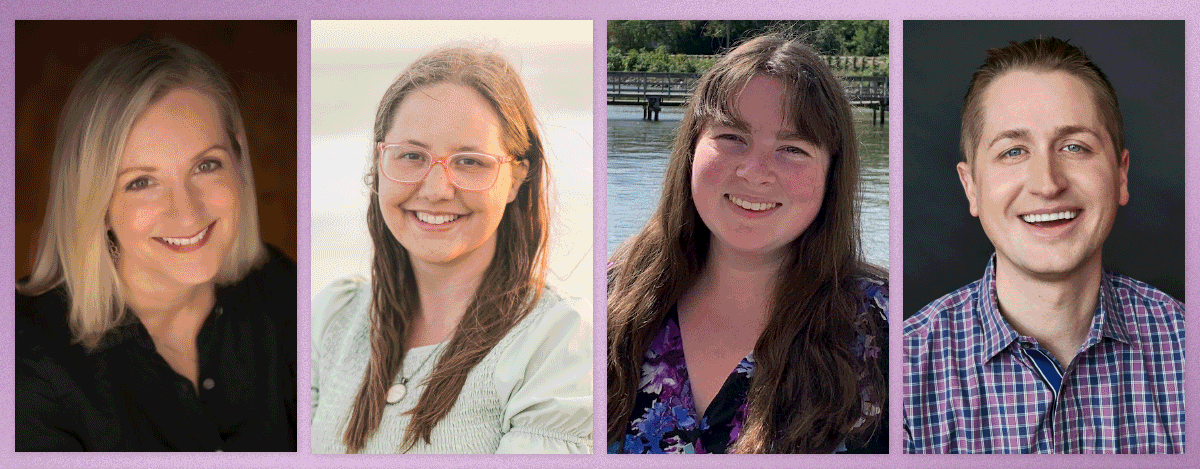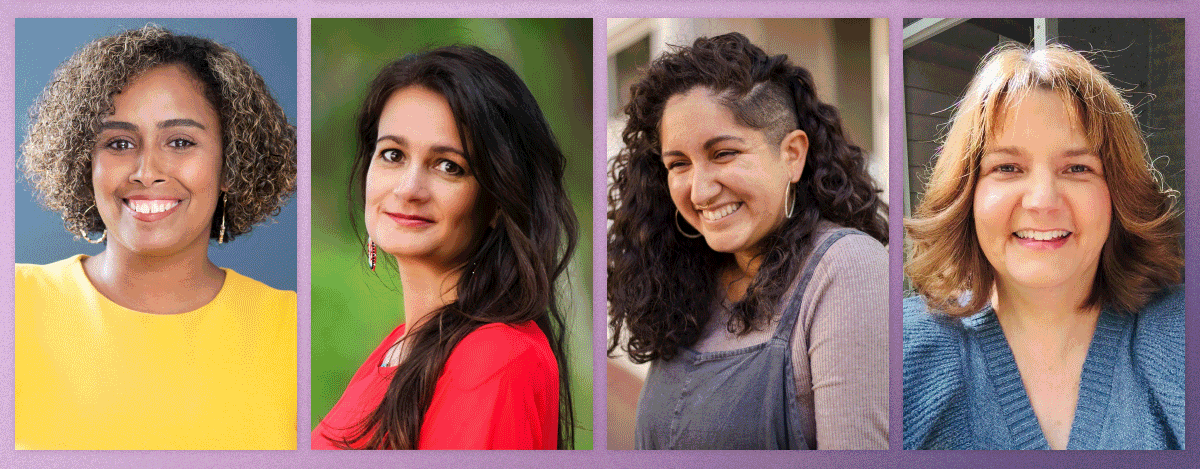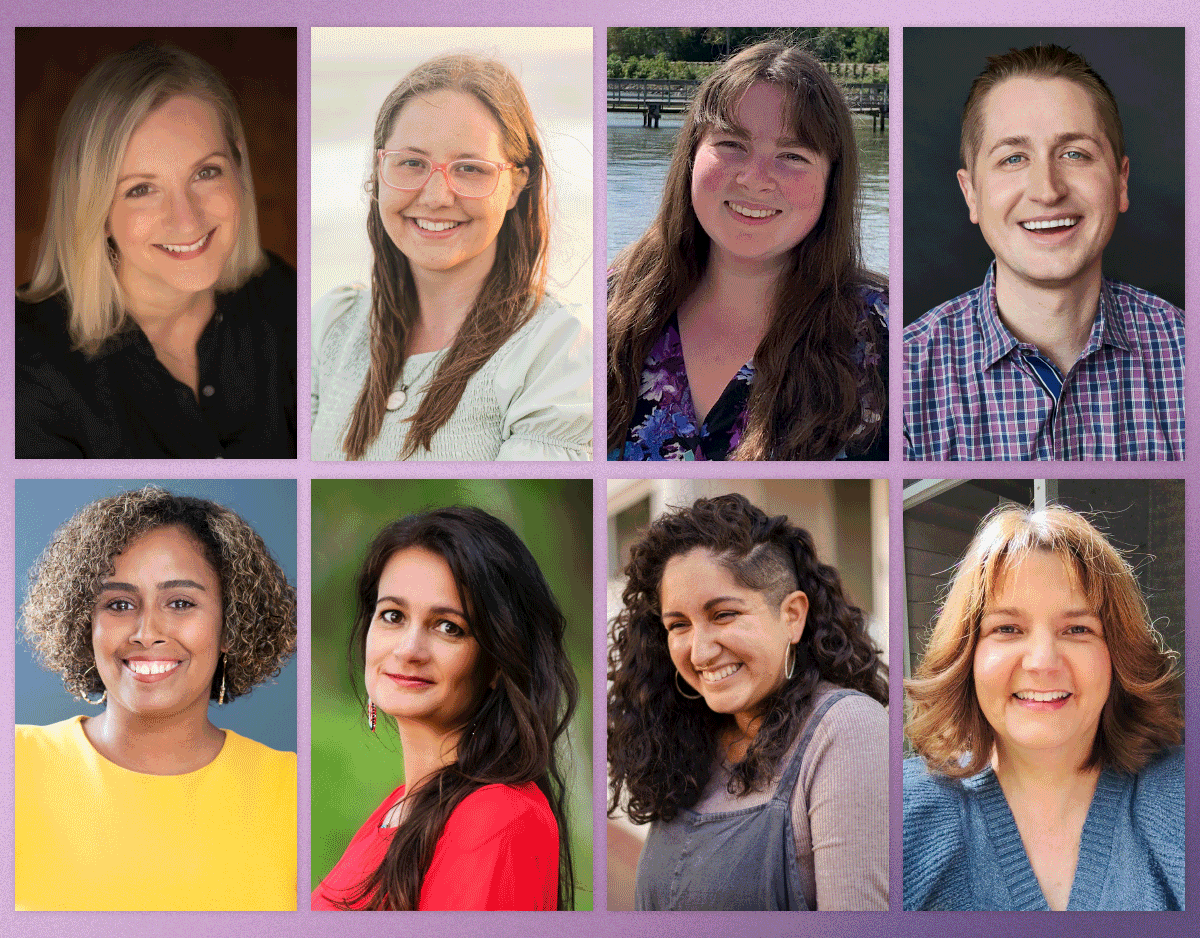As these powerful pieces for middle schoolers show, poetry is a great way to communicate big emotions about disability.

From left: Sally J. Pla, photo by Stephanie Sandell, Cindy Baldwin, photo by Lindsay Allen Photography, Meg Eden Kuyat, photo by Vincent Kuyat, John Xu, photo by Saverio Truglia.
There are many reasons why novelists are drawn to the poetic form, and one notable reason is poetry’s power to portray the emotional and physical realities of the disability experience. Recently, several middle school writers have been using poetry to explore these stories.
“When you’re trying to share a life experience that’s very different from your personal one — when you’re digging deep and trying to say a lot — you might turn to a more poetic form,” says Sally J. Pla, author of the middle-grade verse novel Invisible Isabel (HarperCollins, July 2024). The story follows a girl with undiagnosed autism and anxiety who struggles to fit in with a new girl at school. “High goals require high language, and high emotions require high language,” Pla adds.
Here, Pla and seven other middle grade authors who write fiction in verse featuring characters with disabilities talk about why and how poetry excels as a medium for telling these stories.
[Also read: Disability, Adversity, and Kid Lit: Authors Sally J. Pla and Margaret Finnegan Discuss Disability Representation in Youth Literature | Teen Librarian Toolbox]
Exploring difficult topics
“The poetry really captures the limitations that extreme illness imposes on the body and mind,” says Cindy Baldwin, author of No Matter the Distance (Quill Tree/HarperCollins, 2023), a story about people with cystic fibrosis (CF), who herself has the condition. The novel follows Penny, a teenage girl who bonds with a sick dolphin trapped in a creek in her backyard. The dolphin’s illness reminds Penny of her CF.
Baldwin has written several middle-grade prose novels, but he knew that when he wrote CF characters like himself, he would write them in verse.
“I find poetry to be a great medium for exploring difficult subjects,” she says. “The white space on the page and the brevity of the prose give the reader space to digest difficult ideas. It took me a long time to feel mentally and emotionally ready to write a story based on my own experiences as a CF patient, but the stream-of-consciousness feel of writing in poetry really helped me to effortlessly approach the big emotions in Penny’s story.”
Other writers agree that poetry is well-suited to conveying the big emotions surrounding disability. “For me, writing about discovering a neurodevelopmental disorder in the mainstream world — the exhaustion, overstimulation, confusion of not being able to keep up — was too much for me to capture in prose. In poetry, I was able to make sense of those emotions,” says Meg Eden Kuyat, author of Good Different (Scholastic, 2023).
Kuyat’s protagonist, Serah, often feels overwhelmed and overstimulated at school and at home. After an outburst at a classmate, she realizes she is autistic and goes through the process of fighting for her right to a diagnosis and support.
“Poetry is where you go when there’s something really emotional, something really close, something that just can’t be expressed well in prose,” Kuyat adds. “There’s a saying in musicals that characters sing when their emotions are too strong for words to express. There’s a saying that they dance when their emotions are too strong for music to express. It’s the same with poetry. The emotion has to be strong enough to be expressed in poetry.”
Moreover, poetry is well-suited to “focus on a few characters and recreate a small moment in their experience,” Kuyat points out.
John Shue, who based his debut middle-grade novel, Louder Than Hunger (Candlewick, March 2024), on his own experiences with anorexia, OCD, anxiety, and depression, agrees. The story follows Jake, a man who loves poetry and music, who is driven by an inner voice to restrict his food and disappear. His family sends him to an inpatient treatment facility to get help.
“Jake immediately told me that Louder Than Hunger should be told in poetry,” says Shue. “He spoke to me through poetry: big poems, quiet poems, four-word poems, and multi-page poems. I can’t imagine writing the story any other way.”

Pictured from left: Jasmine Mendez (photo by Tasha Gorrell), Dawn Quigley (photo by Tadpole Photography), Andrea Beatriz Arango (photo by Sierra Creative X/Lily Graciela), and Anne Claire Rusotto (photo courtesy of Anne Claire Rusotto).
Margins and poetic form
Jasmine Mendez, known primarily as a poet, says that using poetry and white space allows her to express what it feels like to have a disability in a way that is accessible to young readers. “For me, it’s important to use imagery, metaphors, and sensory details to really amplify the inner feelings,” says Mendez, author of Aniana del Mar Jumps In (Dial, 2023). Her book depicts the experience of a young Dominican-American swimmer who begins to experience severe pain and swelling in her joints and is eventually diagnosed with juvenile idiopathic arthritis.
“Verse was able to capture that loudness. [of chronic pain] “You can use different font sizes on the page and place words however you want,” Mendes says. “You can write poetry and play with words on the page and where they’re placed, and having individual words stand alone against the white space adds such an emotional experience for the reader.”
Baldwin also sought to reflect his own experiences with disability through form.
“The artistic flexibility of poetry allows me to shape things in ways that reflect the experience of disability,” she says. “When Penny was ill I wrote poems in which every few words were punctuated by a cough – much like speaking when your cystic fibrosis is worsening! In some of the poems from when Penny was in hospital I played around with the form quite a bit to express the disorientation and sensory overwhelm that characterised the hospital experience.”
Similarly, while writing her new novel, Red Bird Danced (HarperCollins/Heartdrum, June 2024), author Dawn Quigley says she “began to understand how authors can use fonts, spacing, and bold/pale colors to create the artistry, mood, and tone of their stories.”
The story alternates between the perspectives of two Ojibwe teenagers living in a Native American urban residential community, one of whom has a reading disability.
“Writing poetry has been so freeing because there’s no one way to do it,” Quigley adds. “I love making my own rules for writing!”
Accessible Presentation
The poetic form allows freedom for the author, but it can also make the characters’ experiences more accessible to the reader.
“Explaining pain to someone, whether it’s brain pain or physical pain, can feel so daunting,” says Andrea Beatriz Arango, author of the Newbery Medal-winning Iveliz Explains It All (Random, 2022) and other poetry collections. The protagonist in Arango’s Iveliz Explains It All, a seventh-grader from Puerto Rico, experiences PTSD after her father dies in a car accident in which they both are involved.
“I think the intimate nature of a novel in verse helps close the communication gap between character and reader just a little bit quicker than a prose book,” she says, “and also makes the book more accessible to readers who benefit from fewer words on the page.”
Reader ease is just as important to other authors. “We tried to make sure that Isabel could read the book quickly and calmly,” says Pla. “There are no big dark blocks of text. There’s enough white space so that the reader can develop a rhythm of slowly turning the pages.”
In Baldwin’s view, “poetry is so instinctive that it can help able-bodied, neurologically normal people better understand points of view other than their own.”
assignment
But creating a poetry-based work comes with hurdles: “For stories with many characters and multi-layered plots, poetry may not be the best medium to express the details and nuances of the story,” Kuyat says. Dialogue can also be difficult, according to Xu.
Mendes argues that maintaining coherence and development is just as important in a novel in verse as it is in a prose work: “There are characters. There are internal and external conflicts. There are subplots, a climax, a denouement.”
But poetry’s simple form often requires you to boil things down to their bare essentials: “It’s hard to find the core, the essence of a scene, and describe just that,” says Pla. [and] “We’re looking for beautiful poetic language that’s very simple and accessible to young readers,” Mendes added.
Despite these challenges, these writers demonstrate poetry’s adaptability in capturing the nuance and complexity of their characters’ diverse experiences.
Anne Claire Lezotte’s upcoming middle grade verse novel, Deer Run Home (Scholastic, October 2024), follows Effie, a deaf teenage girl, as she overcomes abuse and neglect in a family that refuses to help her learn American Sign Language (ASL). One of the ways she finds her voice is by writing poetry that combines English and ASL. In one of Effie’s final poems, she writes about how poetry helped heal her soul: “Poem/letter/word/sentence/page./Poetry./My healing./My soul.”
The healing power of poetry is a theme in many of her other stories: Jake composes poems while in a treatment facility in “Louder Than Hunger,” characters grapple with grief and prejudice through poetry in “Red Bird Danced,” and Penny uses poetry to come to a deeper understanding of her identity in “No Matter the Distance.”
For authors, too, creating such books is often cathartic.
“Writing Louder Than Hunger helped me realize that I was carrying a lot of childhood trauma,” Shue says. “Writing helped me let go of that. It helped me heal.”
Margaret Kingsbury is a journalist and book reviewer based in Nashville, Tennessee. Her work has appeared in BuzzFeed News, IGN, The Observer, The Lily, SLJ, StarTrek.com, Parents, and more. She’s the daily newsletter editor for Hey Nashville and writes Book Riot’s twice-weekly children’s literature newsletter, The Kids Are All Right. Follow her on Instagram at @BabyLibrarians, on Twitter at @AReaderlyMom, and on Bluesky at @AReaderlyMom.

